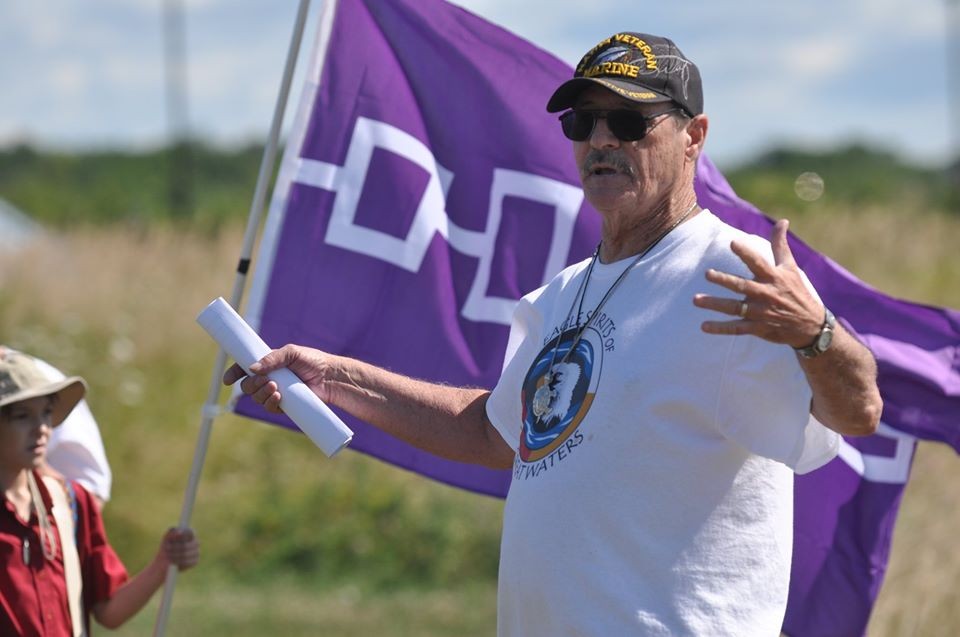
Broken promises on the waterfront as Indigenous Village pushed aside in latest plan for Lakeview
This article was originally published December 7, 2019.
Canada’s Indigenous people have a long history of resilience.
They have survived generations of genocide through violence, famine, disease, the horrors of assimilation, and the residential school system. This has included systemic racism in living conditions, access to healthcare and education, the criminal justice system and the horrifying number of Indigenous children in government care.
Their call to improve standards of living have gone unheard for too long.
The Truth and Reconciliation Commission of Canada was an opportunity for victims of the residential school system to bring their stories forward. It exposed harsh truths from our history.
It started the collective healing and engagement within the Indigenous community. Efforts to document their true history was acknowledged as the first step to reestablishing trust between Indigenous and non-Indigenous Canadians.
Their voices are only getting stronger.
It was common practice in residential schools to torture children into whiteness. A method to stop them from speaking their languages was to put pins through their tongues.
Barry Gilbert is the president of Eagle Spirits of the Great Waters, Indigenous Arts and Cultures, a Mississauga-based group, focused on educating both Indigenous and non-Indigenous people on the history of our land.
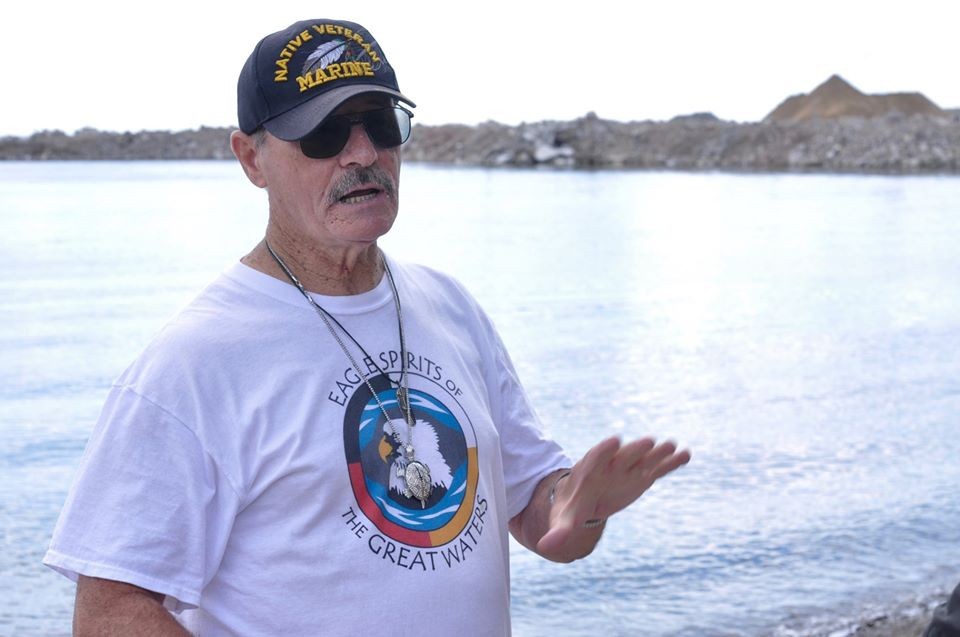
Barry Gilbert, president of Eagle Spirits of the Great Waters, Indigenous Arts and Cultures
The group has 100 members, local and non-local, including artists, professors, even staff from Mississauga-Lakeshore MP Sven Spengemann’s office.
A fire of burning determination has been lit within Gilbert. He talks about how this is a pivotal time in history. He won’t allow his voice – or those of his people – to go unheard.
“[It’s] important that we bring the truth forward. And we have to bring the truth forward. Because to talk about healing, how can we heal and move on to truth and reconciliation if we can’t get past the healing? Part of it now, is to educate people on everything about this history.”
In the end, he said, “[as a people] we’re not going anywhere.”
In an earlier interview with The Pointer, Gilbert explained how version 4.0 of the Lakeview Village project on the old Ontario Power Generation lands, developed in partnership between Lakeview Community Partners Ltd (LCP) and the City of Mississauga, added a small building to their sprawling development, cutting into the edge of an area previously earmarked for an Indigenous education centre and village, along with a water testing facility.
Gilbert says the dismissal cuts deep. He refers to feeling a similar spiritual defeat during his experience at the Supreme Court hearings for the St. Anne’s residential school survivors (Fort Albany, James Bay). “I stop and I think about the untold stories. I was down there with a good politician by the name of Charlie Angus (MP, Timmins-James Bay). I was down there with chiefs from Fort Albany on James Bay and from other reserves up north, and I listened and watched them get treated whereas they could not bring in their own stories anymore. So, that made me angry, and it made me determined to educate people – about the truth of the area, about the truth of what is really going on.”
Gilbert had high hopes for the future – but little faith in those driven by greed: “These land developers [and] these cities talk about things, but they only talk about how to create density, how to build things. They’re to a point where they have no more land, so now we’re going to have to surrender our parks, or our waterfront. And we can’t let that happen anymore. We have to protect something which is us.”
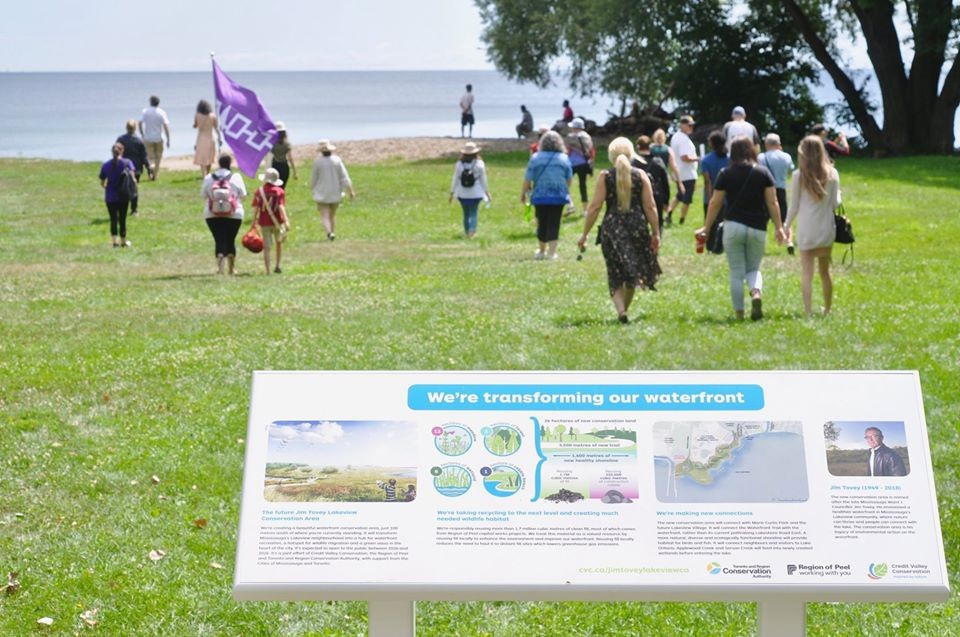
Residents take part in a Walk and Talk event hosted by Eagle Spirits on the Mississauga waterfront.
Gilbert is proudly Six Nations from the Onondaga of the Grand, and a Port Credit resident. He is a strong community figure, an educator, public speaker, and local organizer. He says Eagle Spirits has embraced its role in the community. A walk and talk program on the former hydro lands is all part of its outreach to others. Gilbert and the other founders of the group, Lynn Taylor, Indigenous artist, and Kandy Kennedy, secretary of the board, have been crucial in gaining members and overwhelming community support. Both Taylor and Kennedy are members of the Oneida of The Thames.
A Learning Experience
The Mississauga Waterfront Initiative is a project close to their hearts – an opportunity to connect the past and the present by educating the community on its own history. ‘The Village’ would be a place for people of diverse backgrounds to come and learn about Indigenous art, culture and history. Gilbert is passionate about the centre, and says, “One thing about it, we know social justice.”
This comment signifies even deeper truths.
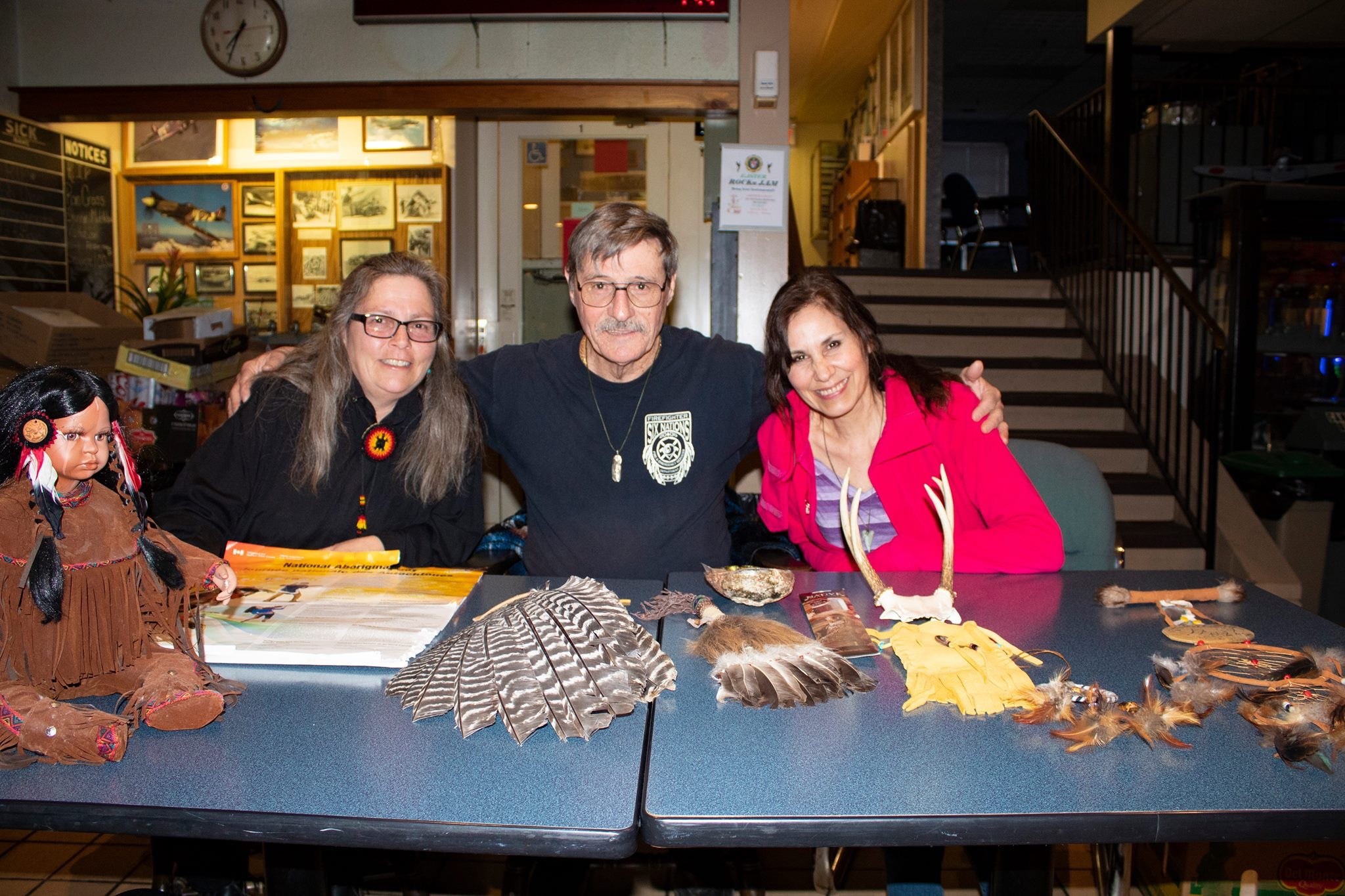
Kandy Kennedy, Barry Gilbert and Julie Taylor of the Eagle Spirits of the Great Water.
A CBC story claims that Indigenous youth made up 46 per cent of admissions to youth correctional services in Canada in 2016-17, while accounting for eight per cent of the youth population. The 2016 census notes that in Canada, 52.2 percent of children in foster care are Indigenous, but account for only 7.7 percent of that demographic. Gilbert tells The Pointer, “54 percent of our Indigenous children are under foster care and 43 percent will never finish post-secondary education... In Vancouver alone, 30 percent of all the homeless are Indigenous children.”
More numbers: suicide rates are 5 to 7 times higher for First Nation Youth than for non-Aboriginals.
With plenty of statistics behind him, Gilbert makes a strong case for education within a community hub of Indigenous culture and history. But the new-look Lakeview development completely cuts out the Village from its plans. Gilbert was disappointed to say the least, and recalled his early involvement when it was first proposed by Jim Tovey (former Ward 1 councillor) and the Lakeview Residents Association.

An early version of the Lakeview Plan, which included the Indigenous Village.
He says, “When I first met with [the present councillors] at City Hall, I brought up the idea of having a Village. They said they would work with us, with the local leaders. And they never come back to talk to us, whatsoever…”
After personally reaching out to Mayor Bonnie Crombie, he left rejected. But Gilbert is even more activated. “I cannot accept one particular group here who feels that ‘we’re gonna do this Indigenous Art Trail, and thank you for showing us,’ but you have to have all these qualities and you have to be known,’ and they’re naming all these people, and every one of them is a white person.”
Eagle Spirits thinks Indigenous art should be done by Indigenous artists. Why the need for cultural appropriation when there are so many talented Indigenous artists across the country who are willing to contribute authentic works? It’s vital to the success of the project that Indigenous people are the ones educating others on their past history, they say. As there is no written language, their stories have been passed down by word of mouth. Who could possibly be more qualified to share their history?
Gilbert is thrilled so many Lakeview residents have come out to meetings and rallied in support of the project. The Eagle Spirits of the Great Waters has contacts with the Lakeview Ratepayers Association, the Lakeview Small Arms Society, the Town of Port Credit Community Association (TOPCA), the local BIA, Ward 1 councillor Stephen Dasko, and Mississauga-Lakeshore MP Sven Spengemann, among others.
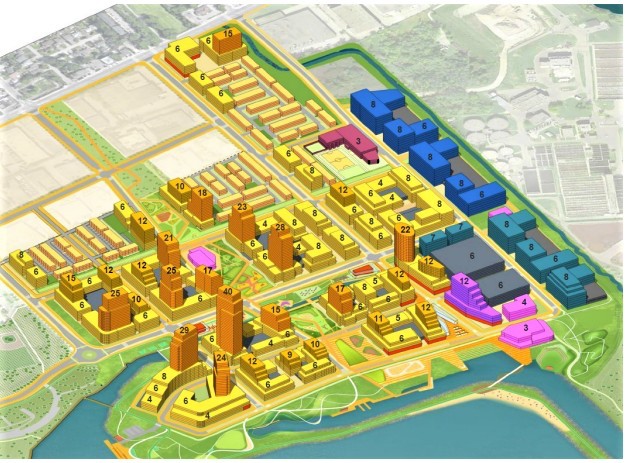
The latest proposal for Lakeview.
Crombie will attend a meeting with members and friends of the Eagle Spirits on Wednesday, December 18th, at the Army, Navy and Air Force (ANAF) Club on Third Street in Lakeview.
She’s had a chance to reflect on the promise she made to the Indigenous community during an event in the series of Canada 150 celebrations, Conference at the Council House, in 2017. According to The City of Mississauga’s website, she is quoted as saying: “The legacy of Indigenous culture on these lands is an essential part of our local heritage. Conference at the Council House gives us pause to reflect on and celebrate this important piece of the City’s history. As a Canada 150 project and now part of our permanent art collection, it gives us the opportunity to learn more about our past while inspiring us to look forward with hope to the future.”
U of T Offers Support
Gilbert’s vision of Indigenous artistry is connected to local Lakeview history and shared by the University of Toronto's School of Cities' Community-Builders Fellowship program, which is partnered with the United Way. The Eagle Spirits Indigenous Village is one of six GTA-based projects that was awarded a $2,000 grant along with ongoing project development opportunities. That includes a qualified, three-person team dedicated to working for the success of the project, which raises the possibility the U of T team can engage Ottawa for federal government funding.
The dream of an Indigenous Village seems enhanced by the continuing work on the Jim Tovey conservation lands, adjacent to the OPG lands development, which will reclaim the natural wonders of the lakefront property. Although this partnership between the conservation authorities in Mississauga and Toronto isn’t formally tied to Lakeview Village, it will sit on its eastern shoulder and is expected to draw about 500,000 visitors each year, most of them students. Gilbert estimates 1 million people would visit the Village annually. The LCP plan will also bring large numbers of children, students, residents and visitors to the waterfront, too. The Village initiative also hopes to attract potential tourists.
Urbanologist Gil Penalosa recently spoke at a TOPCA event and said how important it was that communities create something that is the envy of other across the country. This “will help Mississauga to identify itself across Canada and the world.” He emphasized that “getting it right the first time” should be the goal of those putting together the massive Lakeview Village project.
Indigenous Tourism on the Rise
Since Pearson is the largest, and busiest airport in the country, it’s about time Mississauga takes advantage of untapped opportunities for long-term social and economic growth. According to the B.C. based Indigenous Tourism Association of Canada (ITAC), Indigenous tourism here has grown by $300 million between 2014-2017 to a total of $1.7 billion, including the creation of 7,400 full-time jobs. Overall tourism grew by 14 percent in Canada, but Indigenous tourism is up by 23 percent. “One in three visitors to Canada are interested in an authentic Indigenous tourism experience,” Keith Henry, ITAC president, told CBC News. Henry was recently awarded an honourary Doctor of Laws degree from the University of Guelph for his commitment to the economic development of Indigenous tourism. His initiatives include a national strategy entitled, ‘The Path Forward 2016-2021’. The association also works with governments and tourism associations to ensure Canada is marketed as more than "moose, beavers and RCMP."
Indigenous History in Mississauga
Mississauga has a long history of Indigenous culture. After receiving permission from the self-named Anishinaabe (also referred to as Mississaugans/Ojibwe/Chippewa) Peoples in 1974, the name Toronto Township was changed to Mississauga in honour of First Nations history. And it goes back further than that. Gilbert explains that in the 1800s there were Indigenous men working on the schooners in Port Credit Harbour as part of the stone-hooking business. They were part of rich commercial enterprises with settlers and tradesmen. He continues with an account of 200 Cree women from Saskatchewan coming here to work at the Small Arms building in Lakeview (Lakeshore & Dixie Rds.) during the Second World War. He says there’s a history of many other Indigenous women also working here (upwards of 600, according to Gilbert) to manufacture weapons for the war effort. Many settled in Lakeview to raise their families, and their deep ties remain in the community to this day.
The Mississaugas of the Credit First Nation’s website has an entire page to honour the 96 Indigenous veterans who served Canada in wars past and present. The long history of local Indigenous fighting and dying in service to this country is stunningly showcased.
Gilbert’s points out that knowledge of local and Indigenous history connects the community to its true past, but can only be achieved through education. He believes our commonalities will undoubtedly lead to stronger relations between the Indigenous and non-Indigenous communities with a ripple effect reaching beyond our city limits.
One of the goals for the village, Gilbert explained, was to “take Indigenous and non-Indigenous kids and bring them together and have them learn about each other.”
With a true passion for educating students, and more importantly their teachers, Gilbert discusses the effects on his people to this day. His group wants the Indigenous Village to be a centre for art, culture and education. He knows first-hand the trouble Indigenous children face within our current education system and dedicates most of his time to public speaking at schools across the GTA which helps raise awareness.
The Eagle Spirits’ plans for the Village looks to provide long-term socioeconomic progress and justice to Indigenous people. Gilbert shares this staggering statistic with The Pointer: “The Canadian Centre for the Study of Living Standards calculates that “$71.1 billion would be added to Canada’s economy if aboriginal people simply obtained the same education as other Canadians.”
He said this is how it works: “First [there’s] a funding gap, and then you end up with a real readiness gap. This in turn means the government, our country, and Aboriginal people have an achievement gap, and then of course, we end up with that terrible social-economic gap.”
But the president of Eagle Spirits is no complainer – he has a plan to create the structures the community has needed for decades. The long-term goals include any revenue generated by The Village to be reinvested in on-reserve education, housing for the homeless youth of Mississauga, as well as helping mentally ill and vulnerable people reintegrate into society. The group also hopes to develop lasting partnerships with higher learning institutions to attract interest in Indigenous, Metis and Inuit studies.
This was introduced as an elective in the Ontario secondary schools’ curriculum for the first time by the Ministry of Education this past September.
Serious Generational Trauma
Due to the generational trauma inflicted on many Indigenous people, Gilbert thinks educating First Nation children on their own history will inspire change and healing from within. By also inviting high numbers of non-Indigenous children to the centre, he hopes diverse groups will share their experiences and learn from each other. Working to uplift Indigenous people living on and off reserves and get them out of poverty and trauma, is the ultimate goal.
The idea is to establish a sense of self-sufficiency within the community. “It’s to help children,” says Gilbert, who leans on Statistics Canada data to note that between 2006 and 2015, the population of Indigenous children jumped by almost 43 percent, making it one of the fastest growing demographics in the country. The idea is to develop relationships with each other based on mutual respect for their unique, yet interconnected histories and contributions to Canadian society.
Eagle Spirits hopes to honour the memory of Tovey in building its Village. That dream is now blocked by the City in favour of a massive expansion of the LCP project, which will benefit more the developers. Selling out an opportunity for real progress – tied to the tenets of reconciliation – is nothing less than hypocritical and offensive to Tovey’s memory. States Gilbert: “We just feel like they’re shoving us aside. ‘Thank you for coming, now leave.’ When you’re raised in a society that doesn’t want you, that you’re an embarrassment to the government, [their actions say] ‘we have to hide you and hide the stories, we can’t let the world know.’”
Hard Questions Need Answering
There are some tough questions coming, and many decisions to be made. The December 18th meeting with community activists and the mayor, will be short drive for Crombie due to her recent move to the Lakeview area. Expectations are high. The City has a unique opportunity to create stable and regenerative revenue through tourism, and a chance to invest in the community and future generations. There’s also the advancement in social and economic development, progress in education as well as reconciliation efforts, and essentially, a chance to do the right thing. Gilbert’s group is determined, and he says, “I’ve told City Hall about [similar successful Indigenous projects]. And again, it falls on deaf ears. So, if a group did something and brought non-Indigenous and Indigenous [people] together in harmony rather than in fear of the Boogeyman to realize, hey, you know they’re not that Boogeyman like we thought. If you go and spend some time on the reserve, you will see the kindness, the love that we have.”
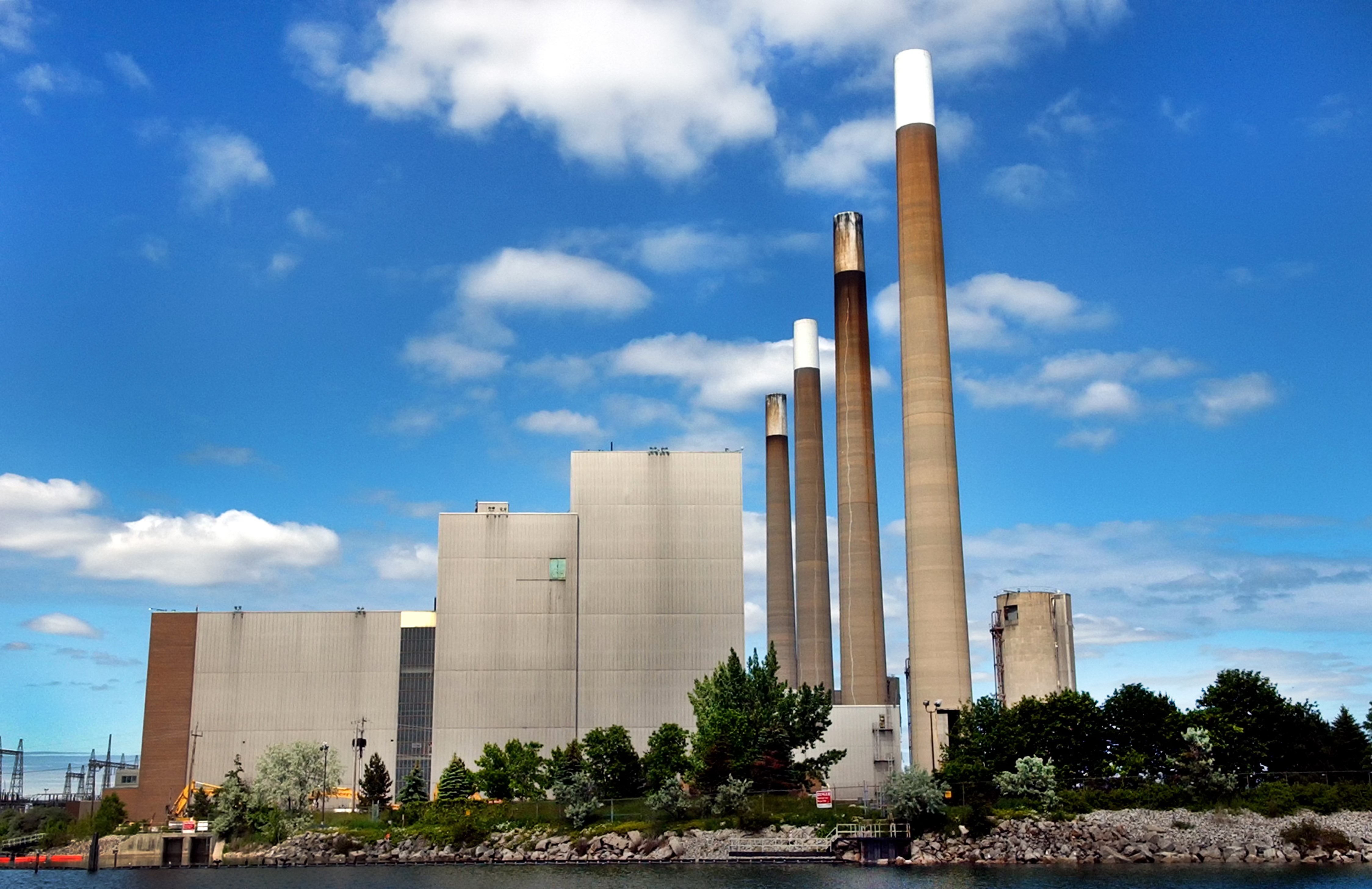
The old Lakeview power plant that previously sat on the site.
He reflects on these broken promises with some pain in his voice. But he also agrees with Penalosa that Mississauga has one last chance to get it right on its waterfront.
If Gilbert still feels pain, that shouldn’t be mistaken for weakness. His words are strong, and even a pin-pierced tongue can be healed.
Refusing to be silenced, he tells The Pointer again, with a renewed sense of conviction: “We’re not going anywhere.”
Submit a correction about this story


